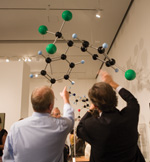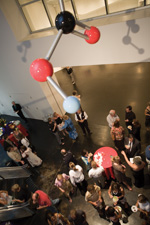Vol.
29 No. 6
November-December 2007
| Where 2B &Y |
| |
Announcements of conferences, symposia, workshops, meetings, and other upcoming activities. |
Molecules that Matter
September 2007–April 2008
Skidmore College, Saratoga Springs, New York, USA
Organic molecules are the stars in a new exhibit that opened on 8 September 2007 at The Frances Young Tang Teaching Museum and Art Gallery at Skidmore College in Saratoga Springs, New York, USA. Titled Molecules that Matter, this new traveling exhibit —created in partnership with the Chemical Heritage Foundation of Philadelphia—tells the story of organic chemistry in the 20th century using molecular models, art, and material culture objects. Each organic compound represents a decade of the century just passed to show the influence of organic chemistry on everyday life.
The exhibit demonstrated that organic chemistry can draw an enthusiastic audience. Molecules that Matter opened with a panel discussion in front of more than 150 people. A larger crowd filled the gallery and reception areas to talk with the artists, archivists, scientists, and other experts who contributed to this dramatic blend of art, science, and artifacts.
 |
| A new view of DDT. Photo by Philip Scalia <philipscalia.com>; reprinted with permission of Skidmore College. |
John Weber, Dayton Director of the Tang Museum, said that after three years of planning, he is delighted at “how well the art cohabits with the huge molecular models and the material culture objects. People responded to different aspects of the exhibit and to how it all fits together. You don’t know until the opening if you got the blend right. Now we know it works. It feels great.”
Introducing the exhibit and moderating the panel discussion were Weber and Ray Giguere, the Skidmore chemistry professor who proposed the original concept and serves as the exhibition’s co-curator and scientific overseer. Giguere explained that the exhibit grew out of a class he taught on the history of science in the 20th century.
The 10 molecules in the exhibit were chosen to represent each decade of the 20th century and collectively represent the cultural changes organic chemistry made in America and around the world. The molecules in order by decade are aspirin isooctane, penicillin, polyethylene, nylon, DNA, progestin (The Pill), DDT, Prozac; and the buckminster-fullerene (carbon 60).
At the end of the panel discussion, Weber and Giguere fielded such questions as “Why not Taxol?” and “What other molecules were considered?” Giguere said the initial list of 200 was pared to 100 then 50 then 20, “then things got difficult.” Others that did not make the cut in addition to Taxol (which was second to Prozac for the 1980s) were cortisone and polystyrene.
 |
| A new view of DDT. Photo by Philip Scalia <philipscalia.com>; reprinted with permission of Skidmore College. |
The Exhibit at the Tang
Molecules that Matter inhabits 3 000 square feet of the second floor of the Tang, with huge molecular models hanging from high ceilings. Next to the staircase hangs the most popular (judging by crowd reaction) of the molecular models, the seven-foot-diameter bucky ball (C-60 carbon sphere). The material culture objects that accompany this model, such as a carbon bike frame, represent the many ways carbon nanotubes and buckminster fullerenes have been employed since their discovery by Richard Smalley, Robert Curl, and Sir Harold Kroto.
On the bridge between the stairs and the main gallery are amber and green stalagmites and stalactites made by artist Jean Shin from thousands of prescription bottles. Three displays hang from the ceiling and four are mounted on the floor, making a dramatic entrance to the main second-floor gallery. Her work introduces the viewer to penicillin.
Off in a corner is the isooctane model. Four- and six-cylinder engines and an old Texaco gas pump are among its material culture objects. This high-octane exhibit also is darker than the others, allowing for better viewing of the two-hour video highlight loop that includes car chases from 40 different films representing more than five decades of movie mayhem.
“It really does look like a mosquito” was the comment several of the exhibit-goers made when one of the many black-clad Tang staff members pointed out the shape of the DDT molecule. Beneath that ominous molecular model were first edition copies of the truly ominous Silent Spring—a book that brought public scrutiny to organic chemistry.
The Chemical Heritage Foundation (CHF) contributed expertise and artifacts to the exhibit, with staff curators providing materials from CHF’s collections and advising on other exhibit materials and on the choice of molecules. Four CHF staff members also contributed articles to the exhibit catalog that will be released soon. The Camille and Henry Dreyfus Foundation, the Hach Scientific Foundation, Friends of the Tang Gallery, and donors to Chemical Heritage Foundation supported the exhibit.
Molecules that Matter will remain on display at the Tang until April 2008 when it will travel to Philadelphia to become the first exhibit in CHF’s new Hach Gallery. In 2009 the exhibit will travel to the College of Wooster in Ohio and other destinations.
Written by Neil Gussman <[email protected]> of the Chemical Heritage Foundation <www.chemheritage.org>.
http://tang.skidmore.edu/pac/mtm/
Page
last modified 19 November 2007.
Copyright © 2003-2007 International Union of Pure and
Applied Chemistry.
Questions regarding the website, please contact [email protected]
|